中考英语答题技巧keywords
中考英语阅读答题技巧及方法
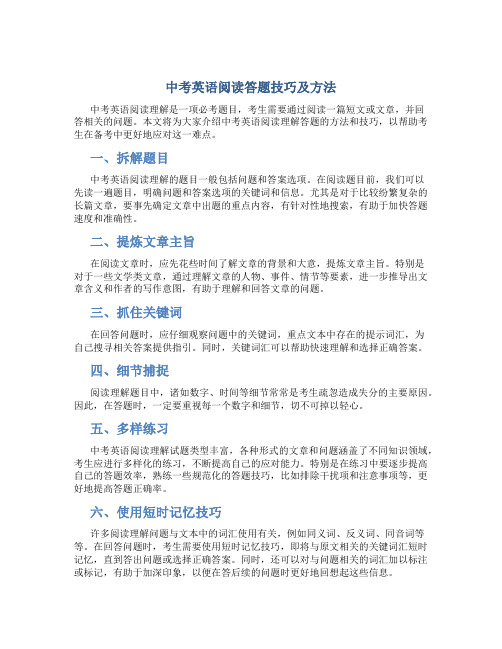
中考英语阅读答题技巧及方法中考英语阅读理解是一项必考题目,考生需要通过阅读一篇短文或文章,并回答相关的问题。
本文将为大家介绍中考英语阅读理解答题的方法和技巧,以帮助考生在备考中更好地应对这一难点。
一、拆解题目中考英语阅读理解的题目一般包括问题和答案选项。
在阅读题目前,我们可以先读一遍题目,明确问题和答案选项的关键词和信息。
尤其是对于比较纷繁复杂的长篇文章,要事先确定文章中出题的重点内容,有针对性地搜索,有助于加快答题速度和准确性。
二、提炼文章主旨在阅读文章时,应先花些时间了解文章的背景和大意,提炼文章主旨。
特别是对于一些文学类文章,通过理解文章的人物、事件、情节等要素,进一步推导出文章含义和作者的写作意图,有助于理解和回答文章的问题。
三、抓住关键词在回答问题时,应仔细观察问题中的关键词,重点文本中存在的提示词汇,为自己搜寻相关答案提供指引。
同时,关键词汇可以帮助快速理解和选择正确答案。
四、细节捕捉阅读理解题目中,诸如数字、时间等细节常常是考生疏忽造成失分的主要原因。
因此,在答题时,一定要重视每一个数字和细节,切不可掉以轻心。
五、多样练习中考英语阅读理解试题类型丰富,各种形式的文章和问题涵盖了不同知识领域,考生应进行多样化的练习,不断提高自己的应对能力。
特别是在练习中要逐步提高自己的答题效率,熟练一些规范化的答题技巧,比如排除干扰项和注意事项等,更好地提高答题正确率。
六、使用短时记忆技巧许多阅读理解问题与文本中的词汇使用有关,例如同义词、反义词、同音词等等。
在回答问题时,考生需要使用短时记忆技巧,即将与原文相关的关键词汇短时记忆,直到答出问题或选择正确答案。
同时,还可以对与问题相关的词汇加以标注或标记,有助于加深印象,以便在答后续的问题时更好地回想起这些信息。
七、阅读速度控制在答题时,阅读速度掌握也是一个非常重要的因素。
考生要根据自己的阅读速度和问题的难度适当掌握时间分配,避免花费过多时间在某个问题上,影响后续的答题进度。
初中英语中考单选题解题方法技巧整理(共15个)

中考英语单选题解题方法技巧01.直接法直接利用相关语法知识,通过题干中的已供信息,捕捉到解题线索,从而得出正确答案的解题方法。
例:--Will you come to the net bars(网吧)with me﹖--Sorry.My mother always tells me______ there.A.not goB.goC.not to goD.to go根据句意可知此题考查动词不定式的否定形式,即tell sb.not to do sth.,故此题应选C。
02.关键词法许多题目中都有这样一些词,它们对于快速而准确地判定答案起着至关重要的作用。
我们称这些词为关键词key words。
找到句中的关键词,也就找到了解题的突破口,例:--He hardly hurt himself in the accident,______ ﹖A.doesn't heB.didn't heC.did heD.does he该题中hardly与hurt是起关键词作用的。
凡陈述部分含有hardly, never, little, few等否定意义的词时,反意疑问句用肯定形式;而hurt一词的过去式与原形相同,此处hurt未加s,应为过去式。
因此本题答案C是正确的。
03.记准固定搭配My cousin and I often ______ on Sundays.A.play footballB.play the footballC.plays the footballD.plays football在本题中,play football是固定短语,play和球类之间没有任何冠词,所以B和C 同时被排除了。
主语是my cousin and I,所以play不加s,D也被排除了。
只剩下A是准确答案了。
04.牢记动词的固定用法I like_______very much and I’d like ______with my friends this afternoon.A.swimming; to swimB.to swim; swimmingC.swimming; swimmingD swim; to swim在本题中,考查了两个固定短语,前者是like doing,后者是would like to do,分辨清楚这两个短语结构,就能准确选出A。
英语中考答题的技巧与方法
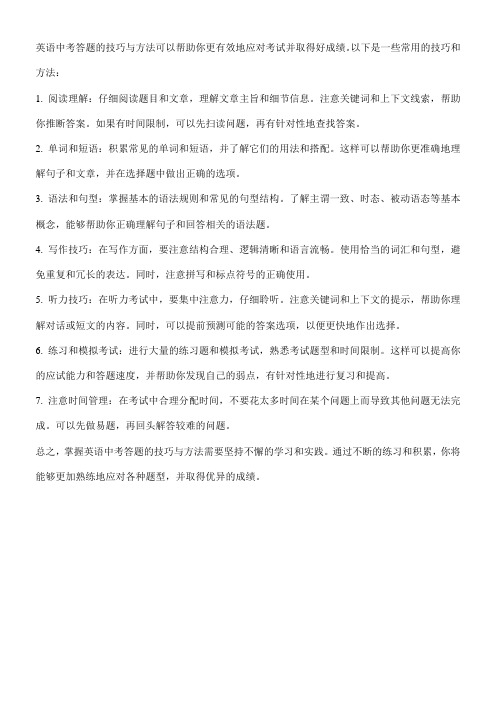
英语中考答题的技巧与方法可以帮助你更有效地应对考试并取得好成绩。
以下是一些常用的技巧和方法:
1. 阅读理解:仔细阅读题目和文章,理解文章主旨和细节信息。
注意关键词和上下文线索,帮助你推断答案。
如果有时间限制,可以先扫读问题,再有针对性地查找答案。
2. 单词和短语:积累常见的单词和短语,并了解它们的用法和搭配。
这样可以帮助你更准确地理解句子和文章,并在选择题中做出正确的选项。
3. 语法和句型:掌握基本的语法规则和常见的句型结构。
了解主谓一致、时态、被动语态等基本概念,能够帮助你正确理解句子和回答相关的语法题。
4. 写作技巧:在写作方面,要注意结构合理、逻辑清晰和语言流畅。
使用恰当的词汇和句型,避免重复和冗长的表达。
同时,注意拼写和标点符号的正确使用。
5. 听力技巧:在听力考试中,要集中注意力,仔细聆听。
注意关键词和上下文的提示,帮助你理解对话或短文的内容。
同时,可以提前预测可能的答案选项,以便更快地作出选择。
6. 练习和模拟考试:进行大量的练习题和模拟考试,熟悉考试题型和时间限制。
这样可以提高你的应试能力和答题速度,并帮助你发现自己的弱点,有针对性地进行复习和提高。
7. 注意时间管理:在考试中合理分配时间,不要花太多时间在某个问题上而导致其他问题无法完成。
可以先做易题,再回头解答较难的问题。
总之,掌握英语中考答题的技巧与方法需要坚持不懈的学习和实践。
通过不断的练习和积累,你将能够更加熟练地应对各种题型,并取得优异的成绩。
中考英语ab篇阅读做题技巧

中考英语ab篇阅读做题技巧Tips for answering AB Passage Reading Questions in Middle School English ExamPassage reading is an important section in middle school English exams. It requires not only good reading comprehension skills but also the ability to analyze and interpret the text. The AB passage reading questions are particularly challenging as they require students to carefully read and understand the text in order to answer the questions correctly. Here are some tips to help you improve your performance in answering AB passage reading questions.1. Skim the passage before reading the questionsBefore jumping into answering the questions, take a few minutes to skim through the passage. Pay attention to the main idea, tone, and organization of the text. This will give you a general idea of what the passage is about and help you understand it better when you read the questions.2. Read the questions carefullyRead the questions carefully and make sure you understand what they are asking for. Pay attention to the key words and phrases in the questions that will help you locate the relevantinformation in the passage. Be on the lookout for words like "according to the passage," "main idea," "opinion," "tone," etc.3. Reread the passageNow that you have a good understanding of the questions, go back and reread the passage more carefully. Look for specific details that will help you answer the questions. Pay attention to the supporting details, examples, and any other information that will help you understand the passage better.4. Eliminate wrong answersWhen answering the multiple choice questions, try to eliminate the wrong answers first. Look for any information in the passage that contradicts the answer choices. Cross out the options that are clearly incorrect and then focus on the remaining choices.5. Use the process of eliminationIf you are unsure about the correct answer, use the process of elimination to narrow down your options. Eliminate the choices that you know are wrong and then make an educated guess based on the information in the passage.6. Check your answersBefore moving on to the next question, make sure to go back and check your answers. Double-check that you have chosen the correct answers and that they are supported by the information in the passage. Make any necessary corrections before submitting your answers.7. Practice regularlyThe key to improving your performance in AB passage reading questions is practice. Make it a habit to regularly practice reading passages and answering questions. This will help you sharpen your reading comprehension skills and become more familiar with the types of questions you are likely to encounter in the exam.By following these tips and practicing regularly, you can improve your performance in AB passage reading questions and ace your middle school English exams. Remember to stay focused, read carefully, and use the information in the passage to answer the questions accurately. Good luck!。
中考英语单选答题技巧

中考英语单选答题技巧
1. 注意前后文:在做题时,要注意前后文的内容,结合上下
文理解,以便判断选项正确性。
2. 排除法:对于一些不确定的题目,可以采用排除法,将错
误的选项划掉,以提高正确性。
3. 着重词汇:很多中考英语单选题在题干中都会有着重词汇,例如: always, never, only, just, every, whole, almost, hardly等,而这些词汇往往可以帮助我们理解题目,选出正确答案。
4. 语法规则:选择题往往涉及到语法规则,把握语法规则可
以帮助我们在做题时更加准确。
5. 细心辨别:在选择题中,往往存在一些类似的选项,这时
需要细心辨别不同,以确保选出正确答案。
6. 多练习:多练习中考英语单选题,可以提高我们选题的速
度和准确性,同时也有利于我们了解中考英语考试出题规律,掌握解题技巧。
中考英语解题技巧
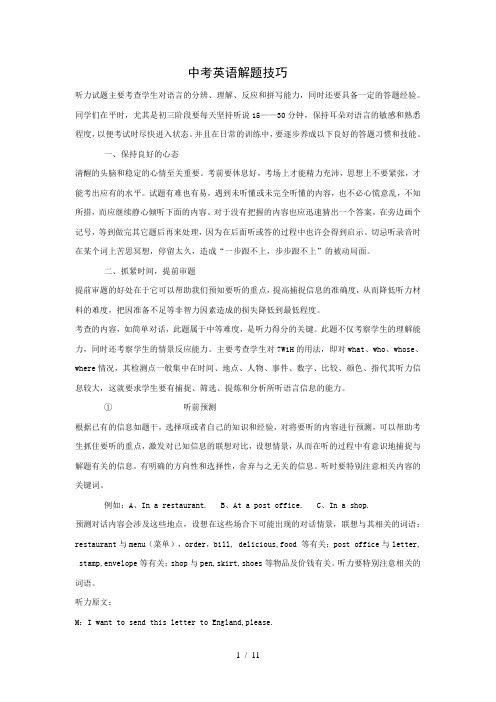
中考英语解题技巧听力试题主要考查学生对语言的分辨、理解、反应和拼写能力,同时还要具备一定的答题经验。
同学们在平时,尤其是初三阶段要每天坚持听说15——30分钟,保持耳朵对语言的敏感和熟悉程度,以便考试时尽快进入状态。
并且在日常的训练中,要逐步养成以下良好的答题习惯和技能。
一、保持良好的心态清醒的头脑和稳定的心情至关重要。
考前要休息好,考场上才能精力充沛,思想上不要紧张,才能考出应有的水平。
试题有难也有易,遇到未听懂或未完全听懂的内容,也不必心慌意乱,不知所措,而应继续静心倾听下面的内容。
对于没有把握的内容也应迅速猜出一个答案,在旁边画个记号,等到做完其它题后再来处理,因为在后面听或答的过程中也许会得到启示。
切忌听录音时在某个词上苦思冥想,停留太久,造成“一步跟不上,步步跟不上”的被动局面。
二、抓紧时间,提前审题提前审题的好处在于它可以帮助我们预知要听的重点,提高捕捉信息的准确度,从而降低听力材料的难度,把因准备不足等非智力因素造成的损失降低到最低程度。
考查的内容,如简单对话,此题属于中等难度,是听力得分的关键。
此题不仅考察学生的理解能力,同时还考察学生的情景反应能力。
主要考查学生对7W1H的用法,即对what、who、whose、where情况,其检测点一般集中在时间、地点、人物、事件、数字、比较、颜色、指代其听力信息较大,这就要求学生要有捕捉、筛选、提炼和分析所听语言信息的能力。
①听前预测根据已有的信息如题干,选择项或者自己的知识和经验,对将要听的内容进行预测,可以帮助考生抓住要听的重点,激发对已知信息的联想对比,设想情景,从而在听的过程中有意识地捕捉与解题有关的信息,有明确的方向性和选择性,舍弃与之无关的信息。
听时要特别注意相关内容的关键词。
例如:A、In a restaurant. B、At a post office. C、In a shop.预测对话内容会涉及这些地点,设想在这些场合下可能出现的对话情景,联想与其相关的词语:restaurant与menu(菜单),order,bill, delicious,food 等有关;post office与letter, stamp,envelope等有关;shop与pen,skirt,shoes等物品及价钱有关。
中考英语考试答题技巧和注意事项
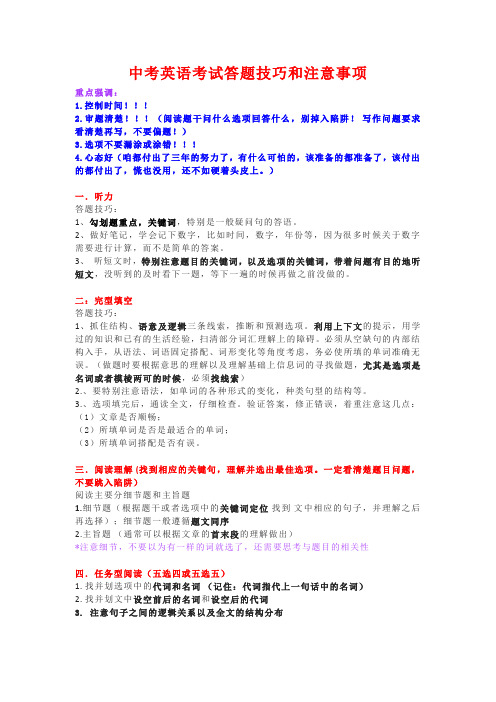
中考英语考试答题技巧和注意事项重点强调:1.控制时间2.审题清楚!!!(阅读题干问什么选项回答什么,别掉入陷阱!写作问题要求看清楚再写,不要偏题!)3.选项不要漏涂或涂错4.心态好(咱都付出了三年的努力了,有什么可怕的,该准备的都准备了,该付出的都付出了,慌也没用,还不如硬着头皮上。
)一.听力答题技巧:1、勾划题重点,关键词,特别是一般疑问句的答语。
2、做好笔记,学会记下数字,比如时间,数字,年份等,因为很多时候关于数字需要进行计算,而不是简单的答案。
3、听短文时,特别注意题目的关键词,以及选项的关键词,带着问题有目的地听短文,没听到的及时看下一题,等下一遍的时候再做之前没做的。
二:完型填空答题技巧:1、抓住结构、语意及逻辑三条线索,推断和预测选项。
利用上下文的提示,用学过的知识和已有的生活经验,扫清部分词汇理解上的障碍。
必须从空缺句的内部结构入手,从语法、词语固定搭配、词形变化等角度考虑,务必使所填的单词准确无误。
(做题时要根据意思的理解以及理解基础上信息词的寻找做题,尤其是选项是名词或者模棱两可的时候,必须找线索)2.、要特别注意语法,如单词的各种形式的变化,种类句型的结构等。
3.、选项填完后,通读全文,仔细检查。
验证答案,修正错误,着重注意这几点:(1)文章是否顺畅;(2)所填单词是否是最适合的单词;(3)所填单词搭配是否有误。
三.阅读理解 (找到相应的关键句,理解并选出最佳选项。
一定看清楚题目问题,不要跳入陷阱)阅读主要分细节题和主旨题1.细节题(根据题干或者选项中的关键词定位找到文中相应的句子,并理解之后再选择);细节题一般遵循题文同序2.主旨题(通常可以根据文章的首末段的理解做出)*注意细节,不要以为有一样的词就选了,还需要思考与题目的相关性四.任务型阅读(五选四或五选五)1. 找并划选项中的代词和名词(记住:代词指代上一句话中的名词)2. 找并划文中设空前后的名词和设空后的代词3. 注意句子之间的逻辑关系以及全文的结构分布五.词汇题1.注意变形(谓语动词注意时态和语态;名词注意单复数;注意动词后的搭配)2.“...地”是副词(一般副词以ly结尾);“...的”是形容词3.横杠前面的信息一定要注意,看看有没有搭配六.语法题1.给提示词(谓语动词注意时态和语态;可数名词注意单复数;形容词注意变副词还是比较级最高级)2.不给提示词(最好先理解句意。
专题10.阅读理解回答问题解题技巧-2024届中考英语题型过关(解析版)

阅读理解回答问题解题技巧解题方法1. 顺序原则,注意使用。
在确定前一道题的答案以后,在文中标注出来。
做下一题的时候,继续往下找,能有效控制答题时间,并提高正确率。
2. 答题之前,圈关键词(Key Words)。
A.大写、数字、引号优先原则B. 5Wh 疑问词必须圈划(who, what, when, why, where, how)例如:1. Jake lost one of his skis after he fell over when skiing, didn’t he?2. When did his parents realized that Jake was missing?3. What did Jake do to protect himself from the cold temperatures?4. How did Jake get down the mountain the next morning?5. How long did it take Jake return to safety after he lost his ski?6. What do you think of Jake? Give at least one reason.3.注意时态一致,代词一致。
例如:(1)Jake lost one of his skis after he fell over when skiing, didn’t he?(回答用一般过去时,代词用he)When did his parents realized that Jake was missing? (回答用一般过去时,代词用they)What do you think of Jake? Give at least one reason.(回答用一般过去时,省略I think,代词用he)(2)Did … mean? 回答:It meant …4.Why 提问,回答格式2种:A..Because + 句子B.…… + to do………(这里to do 表目的)例如:Why did Redmayne say that this Oscar belonged to all of those people around the world battling ALS ?回答:Because he acted as Stephen Hawking in the film and Hawking was diagnosed with ALS.5. Where和When 提问,介词in / on / at 等不能遗漏。
中考英语五选四解题技巧和方法

A. About 48 hours.
承上启下
B. Wow! That’s great!
C. But you didn’t see that on the show.
D. They loved redecorating their neighbors’ place.
E. It sometimes takes several months to remodel a home.
5
• Sometimes kids are glad to hear a “no” from their parents.______
B
A.
There are two types of parents love.
B.
It seems a happy feeling to get out of parents’ control.
make us feel happy.
Be fun!
段首——概括文段,与 小标题相呼应。
3
__G______ Think about the people you most
enjoy being with—usually they are always on
the up and up. Being fun makes people
F. Successful people don’t try to win just one race.
G. But you’ll work a lot harder if there is no
Step 2 Key words 关键词
词汇同现(同一词汇范畴)
Parents should help their children understand money. 71 so you may start talking about money when your child shows an interest in buying things, candy or toys, for
中考英语做题技巧与注意事项

中考英语做题技巧与注意事项一、听力1、试卷发下来第一件事是写学校姓名准考证号,写完迅速浏览所有听力选项(用时3分钟以内),考试试卷上可以随意图画,用笔勾出或者标记出关键词。
2.对于一道题中的三个选项都提到了的,第一遍听完后若没判断出答案,第二遍一定要集中精力,三个选项都提到了的中间一定有关键词把他们区分出来,例如,but,however,too,usually,always,etc.3.听力第三道题是一篇,五道题题干都比较长,切记,务必要在文章开始读之前把所有题干跟选项读完(可以在卷子一发下来那段空余时间和第二大题朗读完之后的几分钟看),并且画出关键词。
有些题目中四个选项都很长,但句式结构都一样,只有中间两三个词不同,就把每句中的这几个关键词圈出来。
Eg: We can learn from the passage that the man is clever and humorous .注意:归根结底就是听力题干和选项要提前看,并且画出关键词。
若第遍没听清楚,不要再回想,迅速集中注意力于第二遍。
二、单项选择。
1、看到题后先读题,然后看选项,判断出题人要考的知识点是什么。
比如,冠词,时态,被动语态,固定搭配,情景交际等等。
2、回想讲过的以及学过的有关知识点,结合选项判断正确答案。
3、选出答案再读一遍看是否通顺,算是检查吧。
注意:切记看到题第一眼就凭感觉随便选,因为目前已你们所掌握的语感还不足以选出正确答案,一定要联系实际,回想讲过的语法点。
若题干很长,一定不要慌,认真静下心来把题读完,题干往往越长,所给出的信息越多,题目越简单。
三、完形填空。
1、完形填空,短文填空和作文是中考英语中最考基本功的三道题。
因为完形填空是以选项形式出题的,所以相对来说较为简单一些。
完形填空考的是学生对于文章整体的理解,所以切记不要一那道题就开始看一个选一个。
开始时,不妨先用一分钟左右是的时间来把文章速读一遍。
2、按照我们之前所讲的方法,即使有些空你不知道选啥,但看了后文会原词复现。
完整版中考英语单项选择题解题技巧

中考英语单项选择题的解题技巧中考英语单项选择题的考点主要散布在:名词、动词、形容词、副词、代词、冠词、连词、介词、神态动词;时态、语态;词义辨析、语序、各样不一样的从句及社交用语上。
在做单项选择题时,掌握一些解题方法是很有必需的。
1.直接法--直接利用有关语法知识,经过题干中的已供信息,捕获到解题线索,进而得出正确答案的解题方法,例:?1--Willyoucometothenetbars(网吧)withme﹖Sorry.Mymotheralwaystellsmethere.A.notgoB.goC.nottogoD.togo依据句意可知本题考察动词不定式的否认形式,即tellsb.nottodosth.,故本题应选C。
2.重点词法--很多题目中都有这样一些词,它们关于迅速而正确地判断答案起着至关重要的作用。
我们称这些词为重点词(keywords)。
找到句中的重点词,也就找到认识题的打破口,例:--Hehardlyhurthimselfintheaccident,﹖A.doesn'theB.didn'theC.didheD.doeshe该题中hardly与hurt是起重点词作用的。
凡陈说部分含有hardly,never,little,few等否认意义的词时,反意疑问句用一定形式;而hurt一词的过去式与原形同样,此处hurt未加s,应为过去式。
所以本题答案C是正确的。
3.类推法--假如对题目的备选答案没有十分掌握或掌握很小,不如利用"如A对,那么B也对"的类推法,进而可将A、B予以否认,例:Who'sthemanatthedoor﹖A.HeisadoctorB.HeisafriendofmineC.HeisafamoussingerD.Heistwenty1/4认真剖析备选答案便可发现:A、C选项针对的是"职业"。
若A是对的,那么C也会是对的。
D回答的是年纪。
中考英语阅读理解九大答题技巧
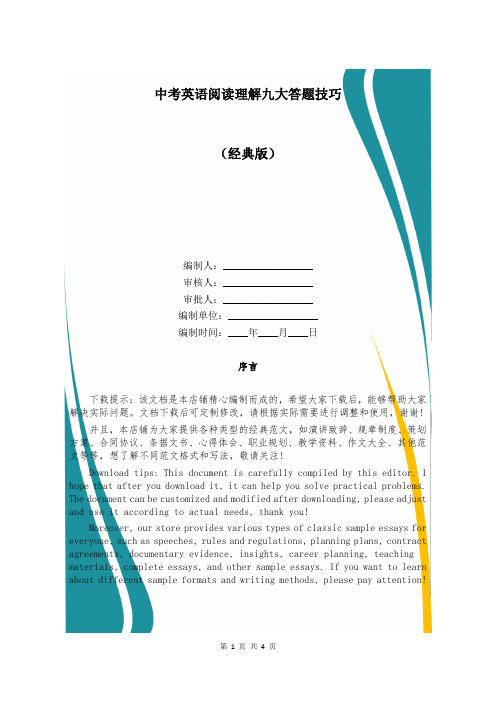
中考英语阅读理解九大答题技巧(经典版)编制人:__________________审核人:__________________审批人:__________________编制单位:__________________编制时间:____年____月____日序言下载提示:该文档是本店铺精心编制而成的,希望大家下载后,能够帮助大家解决实际问题。
文档下载后可定制修改,请根据实际需要进行调整和使用,谢谢!并且,本店铺为大家提供各种类型的经典范文,如演讲致辞、规章制度、策划方案、合同协议、条据文书、心得体会、职业规划、教学资料、作文大全、其他范文等等,想了解不同范文格式和写法,敬请关注!Download tips: This document is carefully compiled by this editor. I hope that after you download it, it can help you solve practical problems. The document can be customized and modified after downloading, please adjust and use it according to actual needs, thank you!Moreover, our store provides various types of classic sample essays for everyone, such as speeches, rules and regulations, planning plans, contract agreements, documentary evidence, insights, career planning, teaching materials, complete essays, and other sample essays. If you want to learn about different sample formats and writing methods, please pay attention!中考英语阅读理解九大答题技巧中考英语阅读理解九大答题技巧_解题步骤有什么中考已经结束啦,那么中考英语的阅读理解答题技巧有哪些呢?接下来本店铺为大家带来了关于“中考英语阅读理解九大答题技巧”的相关内容,方便大家学习了解,希望对您有帮助!内容仅供参考中考英语阅读理解9个答题技巧和方法?1.先浏览全文,迅速了解文章大意。
中考英语做题技巧

中考英语做题技巧中考英语做题技巧是成功考取英语成绩的关键。
在考试过程中,很多同学会遇到一些问题,如时间紧张、难度高等,影响了他们的考试成绩。
以下是一些中考英语做题技巧,希望可以帮助大家提高英语考试成绩。
1. 找出特殊疑问词在做题时,我们可以首先找出题目中的特殊疑问词,如what, where, when, why等。
这些词汇可以帮助我们确定题目的类型,从而更快地找到正确答案。
2. 确定动词时态在阅读文章时,我们需要注意动词的时态。
如果我们能够正确判断动词的时态,就能更快地找到正确答案。
如果题目中没有特别指明时态,我们可以通过句子的语态和上下文来判断。
3. 注意重点单词有些单词在英语语法中是很重要的,如连词、介词、副词等。
在做题时,我们需要特别注意这些单词,因为它们通常是重要的提示。
4. 注意阅读细节在做题时,我们需要注意阅读文章的细节。
有些题目的答案可能隐藏在文章的细节之中,所以我们需要认真仔细地阅读。
5. 利用上下文理解词义有些单词的意思并不是很清楚,但是我们可以通过上下文来进行推测。
在词汇无法正确理解时,我们需要通过上下文进行推测,确定单词的确切位置和意义。
6. 掌握句法结构在做语法题时,我们需要掌握句法结构。
例如,合成句和对比句等都有特殊的语法结构,如果我们能够掌握这些结构,做题就会变得轻松许多。
7. 切勿草率作答在做题时,我们需要认真思考,切勿草率作答。
如果我们犯了错误,则需要尝试及时纠正,避免出现扣分。
8. 认真读题在考试中,我们需要认真读题。
如果我们没有认真读题,就可能会遗漏一些重要的提示,进而做错题目,浪费时间。
9. 提高阅读速度在做阅读题时,我们需要提高阅读速度。
如果我们读得慢,则可能会影响答案的答对率。
阅读练习可以帮助我们提高阅读速度和阅读理解能力。
10. 多做模拟试题最后,我们需要多做模拟试题。
模拟试题可以帮助我们体验真实的考试环境,进而熟悉考试形式和题型。
同时,模拟试题也可以帮助我们查漏补缺,提高自己的水平。
中考英语实用答题技巧(精选3篇)
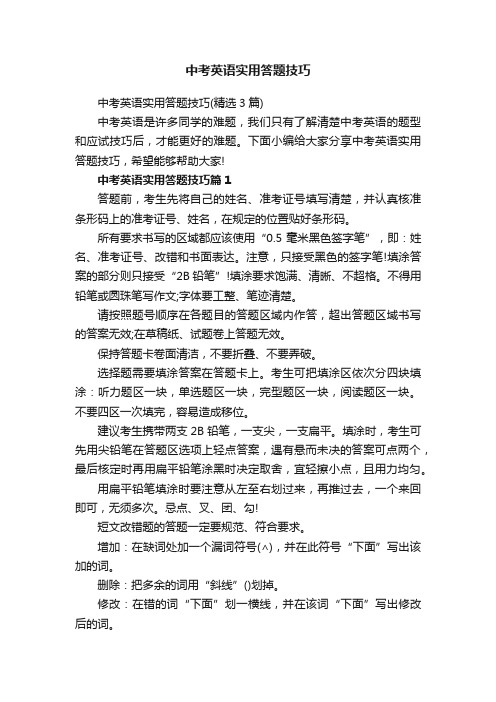
中考英语实用答题技巧中考英语实用答题技巧(精选3篇)中考英语是许多同学的难题,我们只有了解清楚中考英语的题型和应试技巧后,才能更好的难题。
下面小编给大家分享中考英语实用答题技巧,希望能够帮助大家!中考英语实用答题技巧篇1答题前,考生先将自己的姓名、准考证号填写清楚,并认真核准条形码上的准考证号、姓名,在规定的位置贴好条形码。
所有要求书写的区域都应该使用“0.5毫米黑色签字笔”,即:姓名、准考证号、改错和书面表达。
注意,只接受黑色的签字笔!填涂答案的部分则只接受“2B铅笔”!填涂要求饱满、清晰、不超格。
不得用铅笔或圆珠笔写作文;字体要工整、笔迹清楚。
请按照题号顺序在各题目的答题区域内作答,超出答题区域书写的答案无效;在草稿纸、试题卷上答题无效。
保持答题卡卷面清洁,不要折叠、不要弄破。
选择题需要填涂答案在答题卡上。
考生可把填涂区依次分四块填涂:听力题区一块,单选题区一块,完型题区一块,阅读题区一块。
不要四区一次填完,容易造成移位。
建议考生携带两支2B铅笔,一支尖,一支扁平。
填涂时,考生可先用尖铅笔在答题区选项上轻点答案,遇有悬而未决的答案可点两个,最后核定时再用扁平铅笔涂黑时决定取舍,宜轻擦小点,且用力均匀。
用扁平铅笔填涂时要注意从左至右划过来,再推过去,一个来回即可,无须多次。
忌点、叉、团、勾!短文改错题的答题一定要规范、符合要求。
增加:在缺词处加一个漏词符号(∧),并在此符号“下面”写出该加的词。
删除:把多余的词用“斜线”()划掉。
修改:在错的词“下面”划一横线,并在该词“下面”写出修改后的词。
每处错误及其修改均仅限“一”词。
只允许修改10处,多者(从第11处起)不计分。
中考英语实用答题技巧篇21、安排好作息时间。
把每天复习功课、文体活动、休息睡眠的时间安排合理,按计划行事,避免复习时忙忙乱乱,毫无计划,时间长,效果差。
2、进入中考时间节奏。
按照中考科目的考试时间安排自己的复习时间。
这样有助于进入考试状态,有助于在考场上正常发挥。
中考英语 名词词义辨析答题技巧

中考英语名词词义辨析答题技巧Noun Semantic Discrimination Skills in the Middle School English Exam。
In the middle school English exam, students are often required to distinguish the meanings of different nouns. This skill is crucial for understanding and interpreting English texts accurately. In this article, we will discuss some effective techniques to help students improve their noun semantic discrimination skills.First and foremost, it is important to understand the basic definition of a noun. A noun is a word that represents a person, place, thing, or idea. However, within this broad category, there are various subcategories that require careful discernment.One common type of noun that students often confuse is the concrete noun and the abstract noun. Concrete nouns refer to tangible objects that can be perceived through the five senses, such as "apple" or "table." On the other hand, abstract nouns represent ideas, qualities, or emotions, such as "love" or "happiness." To discriminate between these two types, students should pay attention to whether the noun can be physically touched or not.Another pair of nouns that students frequently struggle with is countable nouns and uncountable nouns. Countable nouns can be counted and have both singular and plural forms, such as "book" or "books." Uncountable nouns, on the other hand, cannot be counted and do not have a plural form, such as "water" or "knowledge." To distinguish between these two types, students should consider whether the noun can be quantified or not.Furthermore, students often encounter collective nouns and compound nouns in exams. Collective nouns refer to a group or collection of people or things, such as "team" or "family." Compound nouns are formed by combining two or more words to create a new noun, such as "sunflower" or "firefighter." To differentiate between these two types, students should identify whether the noun represents a group or a combination of words.In addition to these types of nouns, students should also be familiar with proper nouns and common nouns. Proper nouns refer to specific names of people, places, ororganizations, such as "John" or "London." Common nouns, on the other hand, refer to general names of people, places, or things, such as "teacher" or "city." To discriminate between these two types, students should determine whether the noun is a specific name or a general term.To effectively improve noun semantic discrimination skills, students should practice reading and analyzing English texts. They should pay attention to the context in which the noun is used and consider its function within the sentence. Additionally, students can create flashcards or engage in vocabulary games to reinforce their understanding of different noun types.In conclusion, mastering noun semantic discrimination skills is essential for success in the middle school English exam. By understanding the distinctions between concrete and abstract nouns, countable and uncountable nouns, collective and compound nouns, as well as proper and common nouns, students can accurately interpret English texts and answer related questions. With consistent practice and exposure to various noun types, students can enhance their overall language proficiency and excel in their English exams.。
中考英语选择恰当答语题答题技巧

中考英语选择恰当答语题答题技巧全文共6篇示例,供读者参考篇1Here are some tips for answering sentence completion questions on the English entrance exam, written in a conversational style for elementary school students (~2000 words):Hey there! Getting ready for that big English test? Don't sweat it! I've got some awesome tips to help you rock those sentence completion questions. Listen up, because this stuff is golden!First things first, you've gotta read the whole sentence carefully. Like, super carefully. Don't just skim it and pick the first answer that sounds okay. These questions can be tricky, so you need to understand exactly what the sentence is saying before you try to fill in the blank.Next up, think about what kind of word is missing. Is it a noun, verb, adjective, or something else? The answer choices will give you a clue. If they're all verbs, then you know the missing word has to be a verb too. Make sense? Cool, let's keep going.Now, here's where it gets fun. You've got to use context clues to figure out the right answer. Context clues are like little hints in the sentence that tell you what the missing word should be. It might be a word or phrase that gives you an idea of the meaning, or maybe it's something about the grammar or structure of the sentence.For example, let's say the sentence is: "The little girl _____ down the street, skipping happily." See those last few words? "Skipping happily" tells you that the missing word is probably something like "walked" or "ran." You can cross off any answer choices that don't make sense with that context.Another context clue could be something like a contrast word. You know, words like "but," "however," or "although." If the sentence has one of those, it's giving you a hint that the missing word should contrast with whatever comes before or after that contrast word.Oh, and pay attention to any prefixes or suffixes on the answer choices too! If the choices are words like "unhappy," "displeased," and "joyful," you can bet your bottom dollar that the missing word has something to do with feelings or emotions.Okay, one more thing: if you're totally stumped, try plugging each answer choice into the sentence and see which one makesthe most sense. Read it out loud if that helps! Sometimes your brain just needs to hear it to figure out which answer fits best.I know it sounds like a lot, but you've got this! Just take your time, use those context clues, and don't be afraid to re-read the sentence a few times. With a little practice, you'll be a sentence completion master in no time!So there you have it, my top tips for slaying those sentence completion questions. Study up, stay confident, and you're gonna do great on that test! Now go get 'em, champ!篇2Title: Tips for Choosing the Right Answer in English Exam Questions for Middle School Entrance ExamsHey there, English learners! Exams can be prettynerve-wracking, but don't worry, I've got some cool tips to help you ace those English questions, especially the ones where you have to choose the right answer from multiple choices. Just follow these steps, and you'll be a pro in no time!Read the Question CarefullyI know, I know, it sounds obvious, but you'd be surprised how many people rush through the questions without reallyunderstanding what's being asked. Take your time and read the question slowly and carefully. If there are any words you don't understand, try to figure them out from the context or make a note to ask your teacher later.Eliminate the Obvious Wrong AnswersOnce you've read the question, take a look at the answer choices. Sometimes, there will be one or two answers that are clearly wrong. Cross them out or eliminate them from your mind. This will make it easier to focus on the remaining choices.Look for Keyword CluesIn English questions, there are often keyword clues that can help you figure out the right answer. For example, if the question asks for the opposite of a word, look for answer choices that mean the opposite. If the question asks for a synonym, look for answer choices that have a similar meaning.Use Process of EliminationIf you're still unsure after looking at the keyword clues, try using the process of elimination. Cross out the answer choices that you know are wrong, and then choose the best option from the remaining choices.Watch Out for Tricky WordingSometimes, the question writers will try to trick you by using tricky wording or phrasing. For example, they might use double negatives or ask you to choose the answer that is NOT correct. Be careful and read the question slowly to make sure you understand what's being asked.Trust Your InstinctsIf you've tried all the other tips and you're still unsure, trust your instincts. Go with the answer that feels the most right to you. Often, your first instinct is the correct one, so don't second-guess yourself too much.Manage Your Time WiselyDuring the exam, it's important to manage your time wisely. Don't spend too much time on one question – if it's taking too long, skip it and come back to it later if you have time. Focus on the questions you can answer quickly and easily first.Practice, Practice, PracticeFinally, the best way to get better at choosing the right answer in English exam questions is to practice. Do as many practice questions as you can, and take practice tests under timed conditions. The more you practice, the more comfortable and confident you'll feel when it comes to the real exam.So there you have it, my fellow English learners! Follow these tips, and you'll be on your way to acing those English exam questions. Remember, don't get too stressed out – just do your best and have fun with the language. Good luck!篇3Title: Mastering the "Choose the Appropriate Response" Questions in Your Middle School English ExamHey there, fellow students! Are you gearing up for the big middle school English exam? If so, you might be feeling a little nervous about the "Choose the Appropriate Response" section. Don't worry, though – I've got some awesome tips to help you ace this part of the test!First things first, what exactly are these "Choose the Appropriate Response" questions? Basically, you'll be given a short conversation or situation, and then you'll need to pick the best response from a few options. It might sound simple, but trust me, these questions can be trickier than they seem.Tip #1: Read the Entire Conversation or Situation CarefullyBefore you even look at the answer choices, make sure you read the whole conversation or situation slowly and carefully. Payattention to the tone, the context, and any important details that might give you clues about the best response.Tip #2: Put Yourself in the Shoes of the SpeakerImagine you're the person speaking in the conversation or situation. How would you feel? What kind of response would make the most sense based on what's happening? Putting yourself in the speaker's shoes can really help you understand the appropriate tone and content for the response.Tip #3: Eliminate the Obvious Wrong AnswersOnce you've read the conversation or situation and put yourself in the speaker's shoes, take a look at the answer choices. Often, you can quickly eliminate one or two options that are clearly way off base. Cross those out and focus on the remaining choices.Tip #4: Look for Contextual CluesPay close attention to any contextual clues in the conversation or situation that might point you toward the right answer. For example, if the situation mentions that someone is running late, a response like "Sorry I'm late" would probably make sense.Tip #5: Consider the Tone and FormalityIs the conversation casual and friendly, or more formal and polite? The tone and level of formality can be a big clue as to which response is most appropriate. A casual, friendly response might sound out of place in a formal situation, and vice versa.Tip #6: Don't Overthink ItSometimes, the best answer is the simplest, most straightforward one. If an option just feels like the natural, common-sense response, it's probably the right choice. Don't overthink it and get caught up in trying to find hidden meanings or trick answers.Tip #7: Practice, Practice, Practice!The more you practice these types of questions, the better you'll get at recognizing the appropriate responses. Ask your teacher or parents for practice materials, or look for sample questions online. The more experience you have, the easier it'll be to nail these questions on the real exam.Remember, the "Choose the Appropriate Response" section is all about understanding context, tone, and social cues. With a little practice and these tips in mind, you'll be a pro at picking the perfect response every time!So, there you have it – my top tips for conquering the "Choose the Appropriate Response" questions on your middle school English exam. Keep these strategies in mind, and you'll be well on your way to acing this part of the test. Good luck, and happy studying!篇4Here are some tips for answering the "Choose the Appropriate Response" questions on the English exam for the high school entrance exam, written from a student's perspective in about 2000 words:Tips for Choosing the Right Response on English ExamsHi there! My name is Lily and I'm going to share some advice that really helped me on the "Choose the Appropriate Response" section of my English exam. This part can be tricky, but if you follow these tips, you'll be better prepared.First off, it's important to carefully read the conversation or prompt given before the answer choices. Don't just skim it! Pause and make sure you understand who is speaking, the situation, and the tone or emotions conveyed. The right answer will make complete sense when you consider the full context.Next, eliminate any answer choices that are off-topic or don't logically continue the conversation. Those are almost always wrong! The best response will directly relate to what was just said or asked.Pay close attention to the specific wording and implied meanings behind each answer choice too. Sometimes the differences are subtle, but one option will simply "sound" more natural as the appropriate way to respond. Let your intuition as a native speaker guide you.When you're stuck between two plausible choices, look for clues about the level of formality required in that situation. Is it a casual chat with friends or a more formal setting? The degree of politeness and respectfulness in the phrasing can be the deciding factor.Don't get thrown off if there's an idiom or phrasal verbyou're unfamiliar with in one of the answers. While knowing those can help narrow it down, the right response should still be understandable from context clues alone. Focus on the overall meaning rather than getting hung up on specific vocabulary.Here's an example conversation to practice with:Jenny: Hey David, did you finish that English report that's due tomorrow?David: _____A) Yes, I have some good ideas drafted.B) Well, I plan to work on it tonight after dinner.C) No way, that thing is way too long!D) I'm more of a math person if you know what I mean.Can you figure out which response makes the most sense here? Think about the context of Jenny asking about the upcoming deadline. Ruling out C and D right away because they don't actually address her question. Between A and B, option B is probably the better choice because it continues the conversation more naturally by indicating David's future plans to complete the assignment.With a little practice, you'll get the hang of looking for logical conversation cues and choosing responses that keep things progressing smoothly. Don't overthink it, and trust your language intuition!Those are some of my best tips, but feel free to ask your English teacher if you need any other advice specific to the examformat. Just stay focused, and you'll do great! Let me know if any part of this was unclear or if you have additional questions. Wishing you all the best on your upcoming English exam!篇5Title: Cracking the Code: Mastering English Choice Response QuestionsHey there, fellow students! As we gear up for the big Zhongkao exam, one section that can be particularly tricky is the English choice response questions. But fear not, my friends, because I've got some killer tips and tricks up my sleeve to help you conquer this beast!First things first, let's talk about what these choice response questions actually are. Basically, you'll be given a question or a statement, and you'll have to choose the most appropriate response from a list of options. Sounds simple enough, right? Well, not so fast! These questions can be sneaky little devils, designed to test your understanding of English grammar, vocabulary, and even cultural nuances.But here's the thing: with the right strategies, you can turn these questions from nightmares into dream scenarios. Trust me, I've been there, and I've learned a few things along the way.Tip #1: Read the Question Carefully (and then Read it Again)I know, I know, this one seems like a no-brainer, but you'd be surprised how many students rush through the questions and end up missing crucial details. Take your time, read the question slowly, and make sure you understand exactly what it's asking. Look for keywords or phrases that might give you a hint about the right answer.Tip #2: Eliminate the Obvious Wrong AnswersOnce you've read the question thoroughly, take a look at the answer choices. Chances are, at least one or two of them will be obviously wrong or just plain silly. Cross those out right away, and you'll have fewer options to worry about. It's like a little shortcut to narrowing down your choices!Tip #3: Watch out for Tricky WordingThe English language can be a real trickster, with all sorts of confusing idioms, double negatives, and tricky phrasing. Be on the lookout for answer choices that might seem correct at first glance but actually have a different meaning when you dig deeper. Trust your gut instinct, but also double-check the wording to make sure you're not falling into a trap.Tip #4: Consider the ContextA lot of these choice response questions will be based on a short conversation or scenario. Pay close attention to the context clues in the question itself, as well as the answer choices. Think about the tone, the setting, and the relationship between the speakers. These details can help you figure out which response makes the most sense.Tip #5: Practice, Practice, Practice!Like anything in life, the more you practice these choice response questions, the better you'll get at them. Grab some practice tests or workbooks and start drilling. Not only will this help you get familiar with the format and types of questions, but it'll also help you build your confidence. And confidence is key when it comes to tackling these tricky questions.Now, I know what you're thinking: "But Josh, this all seems like a lot of work!" And you're right, it is. But trust me, the effort will be worth it when you're breezing through those choice response questions on exam day.Remember, the key is to stay calm, read carefully, and use your critical thinking skills. Don't get flustered if a question seems tough at first. Take a deep breath, apply these strategies, and you'll be well on your way to English choice response mastery.So, there you have it, my friends – my top tips for conquering the English choice response questions. Study hard, practice like crazy, and most importantly, believe in yourself. You've got this!Good luck, and may the choice response force be with you!篇6Choosing the Right Answers on English Choice QuestionsHey there, fellow students! As we're getting closer to the big English exam for getting into high school, I wanted to share some tips that have really helped me with those tricky choice questions. You know, the ones where you have to pick the right answer from a few options? Those used to drive me crazy, butI've figured out some good strategies to tackle them. Here goes!Tip 1: Read the Whole Thing FirstI know, I know - your first instinct is to just zoom in on the question part. But trust me, it's so much better to read the whole passage or conversation first before even looking at the question. That way, you'll understand the context and main idea, which makes it way easier to pick the right answer choice when you get to the question.Let's say the passage is about a boy joining a soccer team. If you read through it first, you'll know it's about his experiences, challenges, making new friends, etc. Then when a question asks something like "What was the main reason he joined the team?", you'll be able to eliminate silly answer choices because you already know the gist of the passage.Tip 2: Watch for Keyword RepeatsHere's a little trick that has saved me so many times - lookout for words or phrases that are repeated verbatim from the passage in the answer choices. Those are usually a good bet for the right answer!For example, if a passage mentions "the musty smell of old books" and one of the answers uses that exact phrase, there's a pretty good chance it's the right one. The questions writers often pull direct quotes or details right from the passage to use as correct answers.Tip 3: Use Process of EliminationOkay, this one is a biggie! Don't be afraid to cross off the answer choices that are clearly wrong. Even if you're not 100% sure of the right one, eliminating the bad ones brings you closer.Let's say a question asks: "What was the boy's favorite part of soccer practice?" If one of the choices is something like "When it rained during practice," you can probably eliminate that one right away if the passage never mentioned the boy liking rainy practice or anything like that.By crossing off 2-3 options you're fairly sure are wrong, you've drastically improved your odds of selecting the right one from what's left. This is such a valuable skill for any choice question!Tip 4: Make Logical InferencesSometimes you have to make inferences based on context clues and implications in the passage - not everything is directly stated. The good news is, the answer choices often provide clues about the kind of logical inference is required.For instance, let's say a passage talks about a girl feeling nervous before her first dance performance. The question says: "How did the girl likely feel after her performance?" Well, even if it doesn't explicitly state her feelings, you can infer based on things like descriptions of her smiling, getting applause, etc. that she probably felt proud, relieved, accomplished after getting through it.So read answer choices looking for the one that makes the most logical sense based on the hints and implications in the passage. With practice, making those inferences gets easier!Tip 5: Don't Over-Analyze Simple QuestionsOn the flip side, be careful not to way over-think questions that are just asking about obvious facts or details from the passage. Not everything requires making complicated inferences!Sometimes a question will simply ask something straightforward like "What city was John's family moving to?" If the passage clearly states they were moving to Chicago, don't outsmart yourself and pick another city that isn't mentioned at all.With practice, you'll get better at spotting questions that just want you to identify an obvious detail versus ones requiring more critical thinking. But in general, if there's a factual, directly-stated answer choice, don't overthink it and pick something more convoluted unless you're positive that's what the question wants.Tip 6: Check for Habit DistractersThose crafty test writers are pretty tricky - they'll sometimes purposefully include Answer choices that seem plausible based on common habits, assumptions or gender stereotypes...but that aren't actually correct according to the passage. These are called "distracters."For example, let's say a passage is about a girl who plays baseball, and a question asks "What sporty he most enjoy?" Now, based on common assumptions a distracter wrong answer might be "football" or "basketball" because those are stereotypically considered "boy" sports.But if you read closely, the passage clearly says "baseball", so you shouldn't fall for that kind of assumption-baiting wrong answer just because it plays into habitual gender stereotypes about sports. Always read carefully and pick the provable right answer from the passage, not make assumptions!Tip 7: Note Transition Words/PhrasesYou know those little words that guide you through the logical flow of a passage like "however", "for example", "in addition", etc? Pay close attention to transition words and phrases - they give big clues about the proper relationships between ideas.For instance, if one sentence says "Jacob enjoyed playing video games" and the next one starts "However,..." you know that the next sentence is going to express some kind of contrasting idea. That help set up the logical relationship So maybe it goes on to say "However he knew he needed to spend more time studying."Those transition words are like drivinglangneous maps tell the reader when to make a turn to a new or contrasting idea. Noting them carefully can help you understand the overall logical flow and relationship between concepts - which can be super helpful for determining right answer choices.Tip 8: Take Your Time...But Not Too MuchPacing is so important for taking any exam with lots of tricky choice questions. You don't want to rush through carelessly and make silly mistakes. But you also don't want to agonize forever over each question and run ouddenly out of time.My advice? Take your time to read everything fully - don't skim or you may miss important details. But once you've done that, don't linger for ages scrutinizing Over and over if you're feeling pretty confident in your answer choice. Make your best choice and move on.Know roughly how many minutes you can devote to each passage/set so you can chunk out your time appropriately. Spending way too long on any one question throws off your whole timing and leaves you frantically guesaluting at the end. Stay focused but also keep it moving!Tip 9: Check for Double NegativesOoh, these tricksters really get me sometimes! I'm talking about those negatively-phrased questions with negative answer choices. Things like "Which of the following is NOT something the main character disliked about his job?"Phew, did you get all Those negatives? Essentially, you're looking for the positive thing he DID like about the job because of the double negative in the way it's phrased.Any time I see that double or triple negative structure, I make a conscious effort to mentally rephrase it the positive way so my brain doesn't tiegeistelves in knots. It's an easy trap to fall into when you're zipping through questions, so circle/underline any negatives you see to caterally process that kind of wording.Tip 10: Have a Guessing StrategySometimes, despite your best efforts, you're just going to have to take an educated guess on a couple questions. When that's the case, here's my guessing strategy:First, cross off any obvious wrong choices. Then, if two options seem equally plausible to you, there's a better chance of it being the longer, more detaiamended answer choice. The writers tend to make a bigger effort to thoroughly explain/justify the right answers than the short, simple wrong ones.So all else being equal, go for the answer with more details and specifics versus a short, vague option. It's not a guarantee, but it's an educated gamble.This particular guessing technique doesn't apply to every single type of question of course. But in a pinch, having a solid go-to guessing strategy like this can help boost your odds if you absolutely have to choose between two answers.The Bottom LineWell, there you have it - my top 10 tips for slaying those English choice questions on the big exam! I'm sure some of these strategies will resonate more than others based on your own strengths. The main things are:Read thoroughly for context and lookout for key repeated words/phrases.Use process of elimination to cross off obvious wrong answers.Make logical inferences when required, but don't overthink straightforward detail questions.With practice putting all these tactics into action, you。
中考英语单选答题技巧
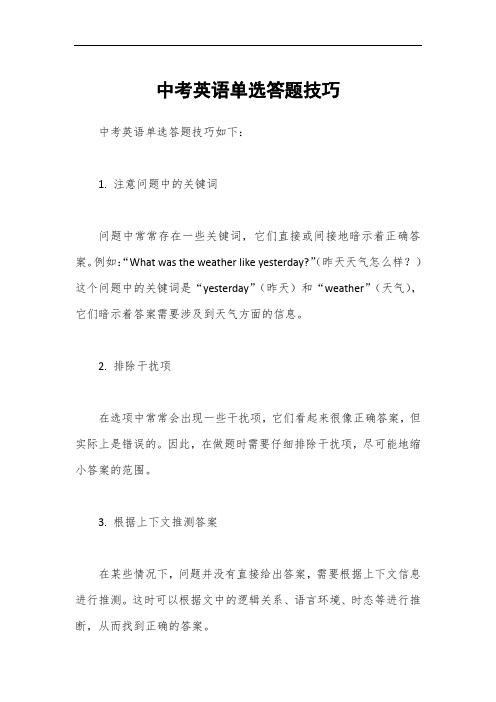
中考英语单选答题技巧
中考英语单选答题技巧如下:
1. 注意问题中的关键词
问题中常常存在一些关键词,它们直接或间接地暗示着正确答案。
例如:“What was the weather like yesterday?”(昨天天气怎么样?)这个问题中的关键词是“yesterday”(昨天)和“weather”(天气),它们暗示着答案需要涉及到天气方面的信息。
2. 排除干扰项
在选项中常常会出现一些干扰项,它们看起来很像正确答案,但实际上是错误的。
因此,在做题时需要仔细排除干扰项,尽可能地缩小答案的范围。
3. 根据上下文推测答案
在某些情况下,问题并没有直接给出答案,需要根据上下文信息进行推测。
这时可以根据文中的逻辑关系、语言环境、时态等进行推断,从而找到正确的答案。
4. 注意选择定语和从句
在某些题目中,需要选出一个合适的定语或者从句来修饰或者承接前面的名词或者句子。
这时需要注意从句的引导词、时态和语态等,选择一个符合语法规则且意思明确的定语或从句。
5. 加强词汇和语法知识储备
在做题时,需要有一定的词汇和语法知识储备,才能更好地理解问题和选出正确答案。
因此,需要加强词汇和语法的学习和积累,提高自己的语言能力和解题水平。
中考英语答题解题技巧
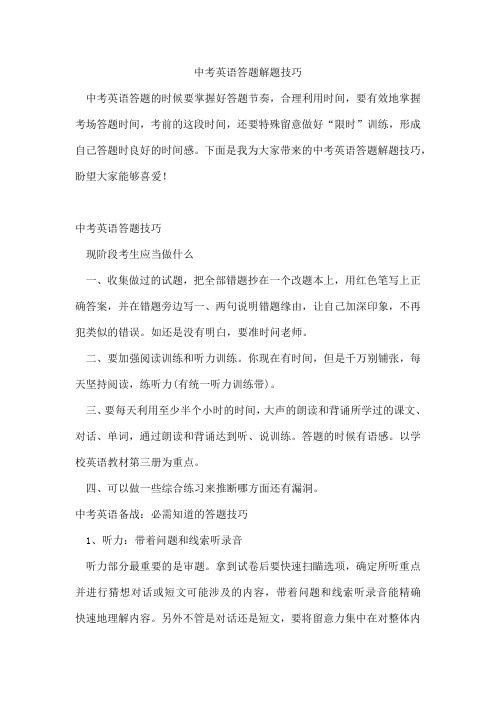
中考英语答题解题技巧中考英语答题的时候要掌握好答题节奏,合理利用时间,要有效地掌握考场答题时间,考前的这段时间,还要特殊留意做好“限时”训练,形成自己答题时良好的时间感。
下面是我为大家带来的中考英语答题解题技巧,盼望大家能够喜爱!中考英语答题技巧现阶段考生应当做什么一、收集做过的试题,把全部错题抄在一个改题本上,用红色笔写上正确答案,并在错题旁边写一、两句说明错题缘由,让自己加深印象,不再犯类似的错误。
如还是没有明白,要准时问老师。
二、要加强阅读训练和听力训练。
你现在有时间,但是千万别铺张,每天坚持阅读,练听力(有统一听力训练带)。
三、要每天利用至少半个小时的时间,大声的朗读和背诵所学过的课文、对话、单词,通过朗读和背诵达到听、说训练。
答题的时候有语感。
以学校英语教材第三册为重点。
四、可以做一些综合练习来推断哪方面还有漏洞。
中考英语备战:必需知道的答题技巧1、听力:带着问题和线索听录音听力部分最重要的是审题。
拿到试卷后要快速扫瞄选项,确定所听重点并进行猜想对话或短文可能涉及的内容,带着问题和线索听录音能精确快速地理解内容。
另外不管是对话还是短文,要将留意力集中在对整体内容的理解上,无须强迫自己听清每个单词,应把重点放在关键词或与问题有关的词句上。
对涉及的时间、地点、人物、大事、数字等有关重要信息要做简洁记录。
当然,心理因素也特别重要,中考听力一般听两遍,假如第一遍没听清晰,千万别惊慌,可以带着第一次的记忆去听其次遍,然后查找与题目要求最接近的答案。
2、阅读理解:文章至少通读两遍近年来中考阅读考查中使用了多种文体的语言材料,考查题虽较大部分依据事实推断,但也有题目必需整体理解归纳才能作出正确解答。
语段可有3%生词,可据上下文猜想、理解。
回答问题的语段除了理解,还要能正确表达,既要会用完整句子回答,又要会有用关键词简略回答力量。
做阅读理解题时,可先扫瞄问题,带着问题通读全文;也可先通读全文再看问题。
